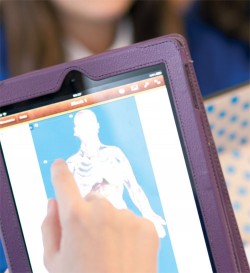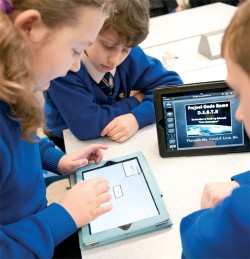BETT 2013
Over 30,000 people will visit BETT 2013… if you’re passionate about technology for learning, then you should be one of them! Jan 30th – Feb 2nd, ExCel London Register at bettshow.com
In today’s multi-media environment it is vital to enrich each student’s classroom experience to stimulate his or her learning. The commitment we expect from children should be reflected in our presentation of their learning experience.
In Tower Hamlets, where I am senior engineer and technical leader on the schools IT team, we believe that now is the time to take advantage of the way children entertain themselves; to employ those same media and thinking habits they foster in their daily lives for the betterment of learning outcomes. Because so much of students’ experience is shaped and surrounded by technology, highly visual interactive activities have truly become the new currency of learning. The education sector’s trade association BESA’s recent research into tablets and apps in schools forecasts that 6.9 per cent of all pupil-facing computers in secondary schools will be tablets by the end of 2012, which shows a significant adoption rate compared with previous years. The report goes on to predict that by the end of 2015 this figure is likely to have risen to 22 per cent.
So, in line with this thinking, over recent months our schools have been considering investing in tablet technology. As an integral part of my professional role I provide schools with advice on the best new technologies for an establishment’s specific needs and then assist in implementation. While I have no experience of classroom teaching, I work with the teachers and school leaders to really immerse myself in their needs, enabling me to research the best options available to them and give them a measured opinion – so let me take you through the review process that I would now recommend to leadership teams thinking about providing handheld personal computers for students.
The first consideration is, why tablet technology at all? One of the key advantages of these devices is the additional engagement that the touch interaction with the content brings. Tablet technology offers a change to the traditional use of ICT, such as fixed computers or laptops. Lightweight with a long battery life, these gadgets offer possibilities not previously seen with other ‘mobile’ computing solutions, such as use on field trips, in workshops or physical education lessons, offering opportunities for research, evidence gathering and presentation. Schools considering investing in tablet computers should therefore review the areas where they would be used most effectively in order to confirm that it is indeed a move worth making.
Once this has been clarified, the key to making exactly the right decisions about how to invest is to have a clear and fundamental understanding of exactly what your school’s needs are. A full awareness of how tablet computers would be used, and what adjustments to the existing infrastructure might be required, is essential. We therefore visited Bett, the world’s leading event for learning technology in London, where we could test and review all available tablets in one day. Taking the most important considerations in turn, these were the questions we wanted answered:
1. Integration with current systems
Our schools, like many others, have made significant investment over the years in a broad range of ICT provisions, which leads to a number of important questions to be asked about tablets including: Will they support our current eLearning content & activities? Can we access our existing network resources? Will they work with our other ICT devices, and how will we control individual user access?
2. Management of multiple devices
Deploying any number of devices will raise another range of questions, such as:
How will we secure the devices and maintain their integrity? How will we manage and monitor these devices remotely? How will we deploy new content and applications to them? How will we provide access to students’ existing work? How configurable is the device and is it easy to secure, manage and provide content over multiple devices?
Deploying a large number of tablet devices, just as with computers and laptops, requires a system to manage, maintain and control them. Without such a solution, tablet devices could create an even bigger burden on ICT provision in schools than existing resources.
3. Total cost of ownership
Despite having a lower price point than laptops, many tablet devices are still relatively expensive. As with any investment the total cost of ownership must always be calculated before purchase. For example, what happens when these devices break or are damaged, and can only proprietary content be used? When we bring in these additional costs, coupled with the potential of having to buy new learning content, the figures can start to escalate.
4. The connectivity issue
With the portability of tablet devices, there is an increased need for mobile connectivity. Providing wireless connectivity for a greater number of more portable devices across a wider geographical area, when most school’s wireless networks were designed to support a small number of devices, is a completely different but fundamentally related consideration. Added to this is the question of the necessary bandwidth to support mobile access to media-rich internet websites and content.

5. Content and application management
With tablet devices and the emergence of ‘app stores’, a new method of sourcing and delivering applications and content is introduced. These stores have been designed for the consumer market and as such do not allow schools to use traditional methods of purchasing and licensing; teachers must also consider whether the content is aligned to the school’s curriculum. Furthermore, without specific content and application management and deployment solutions, delivering new content to multiple devices can be problematic and time consuming. Ensuring that devices can be updated and new content deployed en masse requires critical reflection. The fact that typical deployment of tablets in schools is not yet 1:1 presents another consideration. Inevitably each device will be ‘shared’, as will its content, applications and resources. Finding a way to allow multiple students to access individualised content on shared devices has to be addressed.
6. Control and safety
Finally, and perhaps most significantly of all, it is fair to say that the majority of tablets including the iPad – like the app stores – have been designed for consumer based application and therefore schools must consider how they will monitor and control usage of such devices with specific reference to their duty of care. There are a number of key legal implications including access to content, which must be thoroughly researched before any deployment is considered. Other issues range from content filtering and anti-virus software, to restricted desktop access and student profiling; the nature of mobile tablet devices means there almost certainly needs to be a greater consideration of these management issues.
Clearly, there is a lot to think about. But there’s no denying the attraction; the BESA research mentioned earlier revealed that 82 per cent of the teachers who contributed to the survey said that their pupils have an interest in using tablets. If it’s a route you decide to take, then whichever device you decide is right for your school, I am sure you will experience the same reaction as we did from our students, who are reported to be motivated, engaged throughout lessons, and of course comfortable using the technology. This is the hardware and software that will undoubtedly be a part of the future careers of the young people currently in our care – it makes total sense, then, to incorporate it into their classroom experience, helping to make their learning both meaningful and relevant to the world in which they are living.

Devices and desires
There is a range of different tablet based devices available, each with assorted benefits and limitations. Understanding each product, its key features, and how it can be used within the school environment will assist an educational establishment with its choice of tablet computer investment.
There has certainly been a lot of vocalisation in the market about Apple’s iPad, for example, with many schools (including Honywood in Essex, pictured on these pages) adopting this technology. In my mind it is a great piece of hardware – but my job was to consider if it was right for our educational environments. It’s by no means the only option of course – just a year after its launch in 2010, it was joined by the first generation of tablet computers produced by industry leading hardware manufacturers, including Samsung, Motorola, Lenovo, Toshiba, Acer and Asus. These devices utilised Google’s mobile OS, Android. Several other tablet devices have since joined the marketplace based on proprietary OS, including Research In Motion’s Blackberry Playbook and HP’s TouchPad.
Ultimately, for us, it turned out to be the Avantis LearnPad that best suited our needs. Geared specifically for use within learning and teaching, the hardware and content of the device showed an appreciation of the needs of schools; it’s very manageable and easy to network, and the price was significantly less than many of its rivals. Your school may require a different solution – and the only way to identify it is to make sure you are as familiar as possible with all the options.
About the author
Melvyn Atkins is senior engineer and technical leader on the schools IT team, at the London Borough of Tower Hamlets.










“By the end of 2015 the percentageof tablets will have risen to 22 per cent of all pupil-facing computers”